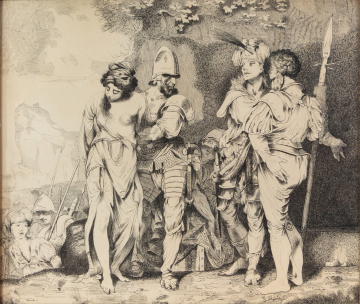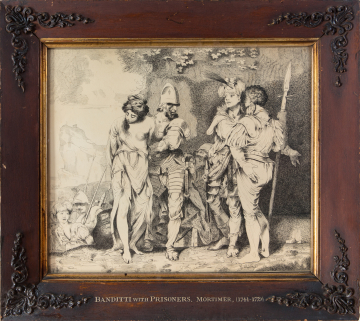Explore Collections


You are here:
CollectionsOnline
/
Banditti with captives
Browse
John Hamilton Mortimer ARA (1740 - 1779)
Banditti with captives
Museum number: P20
On display: Dressing Room
All spaces are in No. 13 Lincoln's Inn Fields unless identified as in No. 12, Soane's first house.
For tours https://www.soane.org/your-visit
Curatorial note
One of a pair of etchings of banditti by Mortimer which hang on the north wall of Soane's Dressing Room on the ground floor, in identical frames.
The scene is set outside the bandits cave with the figures dressed in romantic historicised costumes. The central figure is a bandit in armour and helmet, holding a female prisoner, her clothes partially ripped from her body to reveal one breast. To the right two other men look on: on the far right one stands with his back to the viewer and wearing an elaborate slashed doublet - he has a hand on one hip and a spiked spear in his other hand. The second man wears a plumed turban. All three men have swords hanging from their belts. Between the two groups kneels a third man. Further brigands are seen on the left in the distance, approaching and escorting further captives wearing turbans.
Etched in reverse by Robert Blyth, 1780. Soane's pair of etchings have had the inscription and plate marks trimmed off to enable them to be close-framed to resemble original drawings.
The inscription on the untrimmed etching (see example in the British Museum no. 1865,0610.1039) reads: Drawn by J. Mortimer 1775 / Etch'd by R. Blyth and Banditti returning / From an Original Drawing of J. Mortimer, in the Collection of Richard Payne Knight Esq.r / London, Publish'd as the Act directs Nov.r 9th 1780, by R. Blyth No. 27, Great Castle Street, Cavendish Square.
The original drawing by Mortimer is in the British Museum (Museum no. Oo,5.9), dated to 1775.
The scene is set outside the bandits cave with the figures dressed in romantic historicised costumes. The central figure is a bandit in armour and helmet, holding a female prisoner, her clothes partially ripped from her body to reveal one breast. To the right two other men look on: on the far right one stands with his back to the viewer and wearing an elaborate slashed doublet - he has a hand on one hip and a spiked spear in his other hand. The second man wears a plumed turban. All three men have swords hanging from their belts. Between the two groups kneels a third man. Further brigands are seen on the left in the distance, approaching and escorting further captives wearing turbans.
Etched in reverse by Robert Blyth, 1780. Soane's pair of etchings have had the inscription and plate marks trimmed off to enable them to be close-framed to resemble original drawings.
The inscription on the untrimmed etching (see example in the British Museum no. 1865,0610.1039) reads: Drawn by J. Mortimer 1775 / Etch'd by R. Blyth and Banditti returning / From an Original Drawing of J. Mortimer, in the Collection of Richard Payne Knight Esq.r / London, Publish'd as the Act directs Nov.r 9th 1780, by R. Blyth No. 27, Great Castle Street, Cavendish Square.
The original drawing by Mortimer is in the British Museum (Museum no. Oo,5.9), dated to 1775.
Literature
For a detailed account of Mortimer's life and work see John Sunderland, John Hamilton Mortimer, 1740-1779, The Volume of the Walpole Society, 1986 (vol. 52)
Reproduced and discussed in M. Myrone, 'Bodybuilding: Reforming Masculinities in British Art 1750-1810', fig. 76, pp. 141-2
Reproduced and discussed in M. Myrone, 'Bodybuilding: Reforming Masculinities in British Art 1750-1810', fig. 76, pp. 141-2
Associated items
P23, pair
Soane collections online is being continually updated. If you wish to find out more or if you have any further information about this object please contact us: worksofart@soane.org.uk




